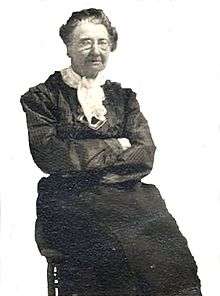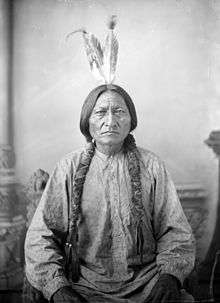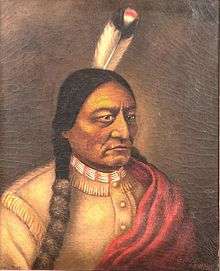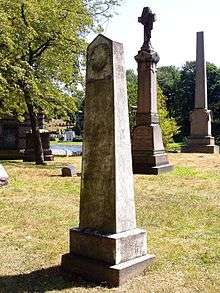Caroline Weldon
| Caroline Weldon | |
|---|---|
 Weldon in 1915 | |
| Born |
Susanna Carolina Faesch 4 December 1844 Kleinbasel, Canton Basel, Switzerland |
| Died |
15 March 1921 (aged 76) Brooklyn, New York, United States |
| Pen name | Caroline Weldon |
| Occupation | Artist, Indian Rights Activist |
| Nationality | Swiss, American |
| Spouse |
Bernhard Claudius Schlatter (m. 1866; div. 1883) |
| Children | 1 |
Caroline Weldon (December 4, 1844 - March 15, 1921) was a Swiss-American artist and activist with the National Indian Defense Association. Weldon became a confidante and the personal secretary to the Lakota Sioux Indian leader Sitting Bull during the time when Plains Indians had adopted the Ghost Dance movement.
Early life and education
Caroline Weldon was born Susanna Karolina Faesch on December 4, 1844 in Kleinbasel, Canton Basel, Switzerland.[1] Her father was Johann Lukas Faesch, a career Swiss mercenary military officer serving in a Swiss regiment in France; her mother was Anna Maria Barbara, née Marti. She arrived in America in 1852, together with her mother, settling in Brooklyn. That year, her mother was remarried to the exiled German revolutionary and physician, Dr. Karl Heinrich Valentiny, who ran a medical practice in Brooklyn. In 1866, Susanna Carolina Faesch was married in Brooklyn to Dr. Bernhard Claudius Schlatter, a physician and fellow Swiss. Her marriage to Schlatter remained childless and was an unhappy one. In June 1876 she ran away with a married man identified in court records as Christopher J. Stevenson. Living with Stevenson briefly in a rented apartment in Hoboken, NJ, she gave birth to a child in late 1876 or early 1877, a boy she named Christie. However her romantic relationship with Stevenson did not last for he would soon abandon her to return to his wife of many years. Caroline was compelled to return to Brooklyn to live with her mother and stepfather. Her estranged husband Bernhard Schlatter filed for divorce which was granted in 1883.[2][3]
Career

Weldon pursued her interests in art. After her divorce from her husband and having been abandoned by her lover she became committed to the cause of Native Americans. Upon the death of her mother in 1887 she had inherited some money which gave her the means to freely pursue her interests. Sometime thereafter she changed her name to Caroline Weldon, presumably to allow her to put her past behind her, although her exact reasons for this action remain unknown. In the summer of 1889 Caroline Weldon traveled to Dakota Territory to fulfill her dream of living among the Sioux. She had joined NIDA, the National Indian Defense Association, headed by Dr. Thomas Bland and his wife Cora Bland, embarking on a quest to aid the Sioux in their struggle to fight the US government’s attempt under the Dawes Act to expropriate vast portions of the Great Sioux Reservation for the purpose of opening same up for white settlement and with the intent of rendering the creations of the two new states of North Dakota and South Dakota economically viable. She befriended Sitting Bull, leader of the traditionalist faction among the Sioux acting as his secretary, interpreter and advocate. After she had moved with her young son Christie to live at Sitting Bull’s compound on the Grand River at Standing Rock Indian Reservation, her confrontations and open defiance of Indian Agent James McLaughlin did not endear her to the general public. McLaughlin initiated a smear campaign, resulting in her being hated and reviled by much of the white community and vilified in the national press. When in the summer of 1890 the Ghost Dance Movement swept through the Indian Reservations of the West she denounced it and warned Sitting Bull that it would give the government an excuse to harm him and to summon the military for intervention which would result in the destruction of the Sioux Nation. Sitting Bull turned against her and upon her son falling ill in November she decided to leave. The subsequent events of Sitting Bull’s murder and the Wounded Knee Massacre the following December proved her right, adding to her sense of futility and failure. Her son died on November 19, 1890 while on the riverboat Chaska near Pierre, SD. She had been on her way to her new home in Kansas City, MO. She lived briefly in the latter city with her nephew Friedrich William Schleicher, a school teacher, only to return eventually to Brooklyn. She disappeared into obscurity soon after.[4][5][6][7][8][9]
Weldon painted four portraits of Sitting Bull of which two are known to have survived. One is now held by the North Dakota Historical Society in Bismarck, ND and the other at the Historic Arkansas Museum in Little Rock, AR.

Later life

Weldon died alone in her Brooklyn apartment on 15 March 1921. The cause of death was accidental third degree burns from a candle to her face and body. She was interred at the Valentiny family plot at Green Wood Cemetery in Brooklyn, NY - Lot 13387, Section 41.[10]
In popular culture
The poet and playwright Derek Walcott refers to Weldon and her life in his play The Ghost Dance and in his epic poem Omeros. He features Native American history together with that of the demise of the Native Arawak people in St. Lucia, in the Caribbean.
The motion picture Woman Walks Ahead, 2018 by Bedford Falls Productions, Santa Monica, CA starring Jessica Chastain and Michael Greyeyes, directed by Susanna White, chronicles Weldon's life among the Sioux.
Green-Wood Cemetery in Brooklyn, N.Y., celebrated Women's History Month by hosting a special trolley tour called "Women Who Walked Ahead" on 31 March 2018 and it included the graves (both marked & unmarked) of notable women from Brooklyn, including Caroline Weldon.[11]
References
- ↑ Faesch Familien Archiv, Staatsarchiv des Kantons Basel, Basel, Switzerland, (Ref. StABS, PA397a, Gerichtsarchiv U152, Uc7)
- ↑ Superior Court, New York County, volume 62, pp. 177 ff. Divorce Record Schlatter vs. Schlatter 1883, New York State Supreme Court, Civil Branch, 31 Chamber Street, 7th Floor, New York NY 10007
- ↑ Caroline Weldon genealogy http://worldconnect.rootsweb.ancestry.com/cgi-bin/igm.cgi?op=GET&db=caroline_weldon&id=I03
- ↑ Pollack, Eileen. Woman Walking Ahead: In Search of Catherine Weldon and Sitting Bull. Albuquerque: University of New Mexico Press, 2002
- ↑ Richardson, Heather Cox. Wounded Knee: Party Politics and the Road to an American Massacre. New York: Basic Books, 2010
- ↑ McLaughlin, James. 1910. My Friend the Indian http://babel.hathitrust.org/cgi/pt?id=loc.ark:/13960/t00008872;view=1up;seq=11
- ↑ Matteoni, Norman E. Prairie Man. The Struggle between Sitting Bull and Indian Agent James McLaughlin. Guilford CT: 2015
- ↑ Stanley Vestal Papers, University of Oklahoma Library Archives, Prof. Walter Stanley Campbell (1877-1957) https://digital.libraries.ou.edu/whc/nam/collection.asp?cID=1224&sID=7
- ↑ Vestal, Stanley (aka Campbell, Walter Stanley). New Sources of Indian History 1850-1891, University of Oklahoma Press, Norman, OK, 1934; transcripts of letters written by Caroline Weldon
- ↑ Caroline Weldon burial site. http://www.findagrave.com/cgi-bin/fg.cgi?page=gr&GSln=Weldon&GSfn=Susanna&GSbyrel=all&GSdyrel=all&GSob=n&GRid=57225492&df=all&
- ↑ Green-Wood Cemetery, 27 March 2018 https://www.green-wood.com/event/women-who-walked-ahead/